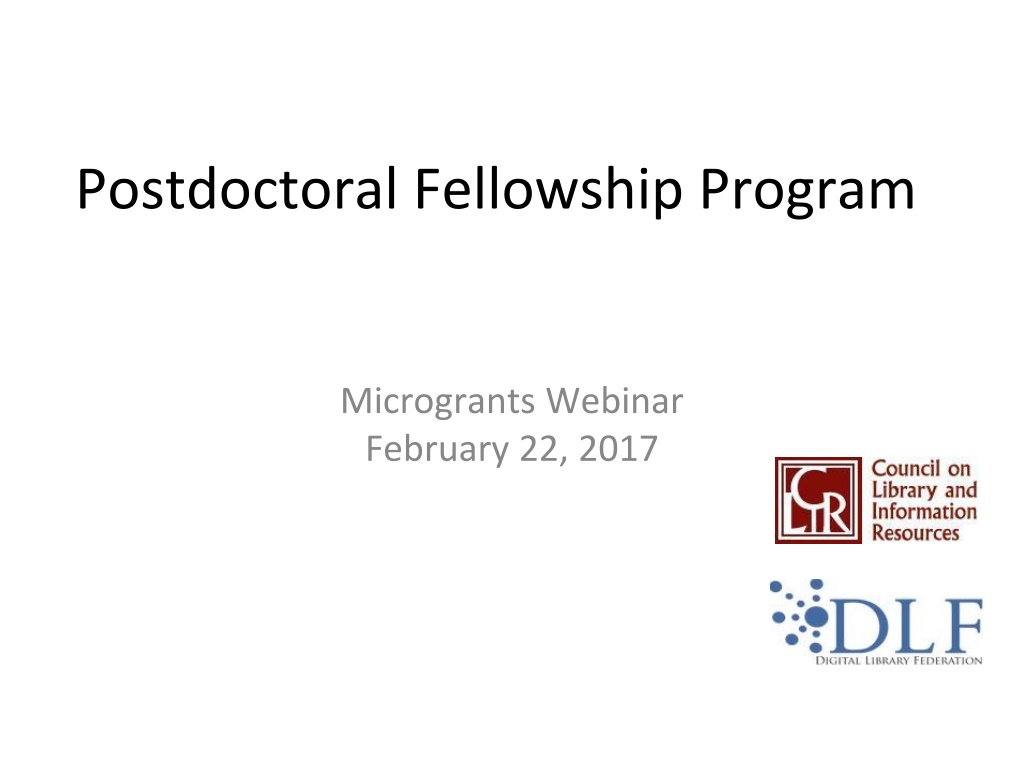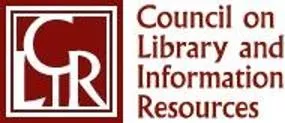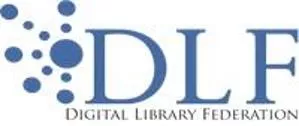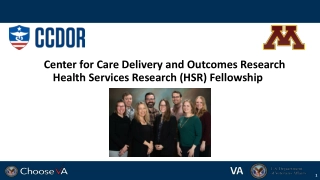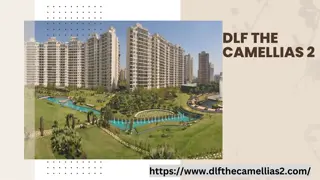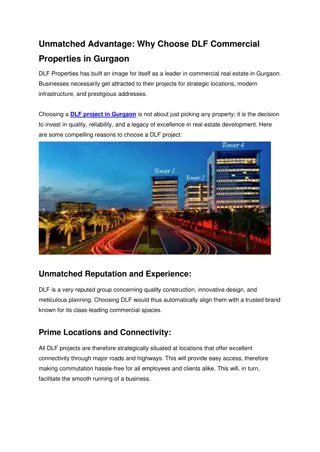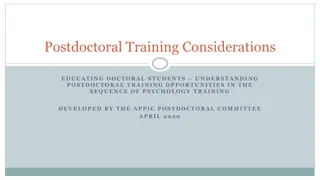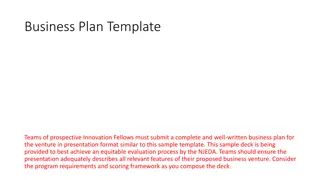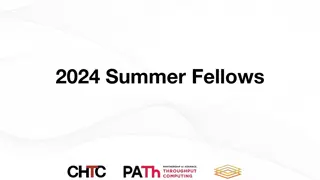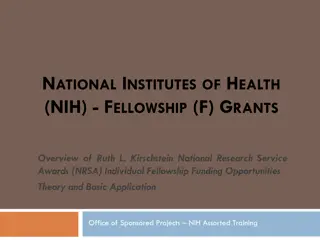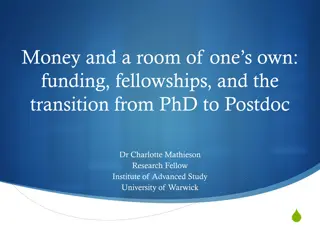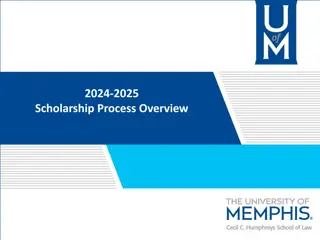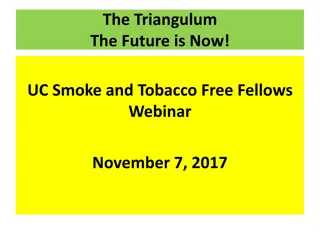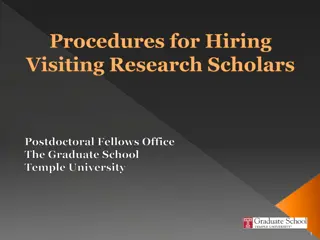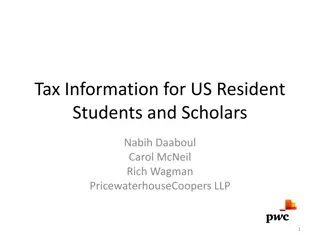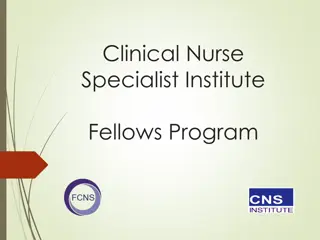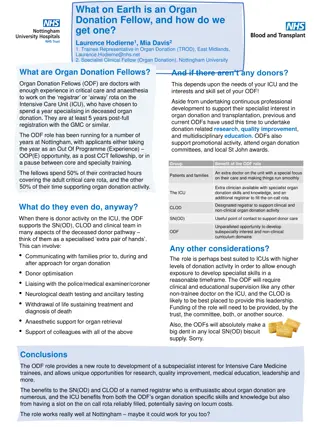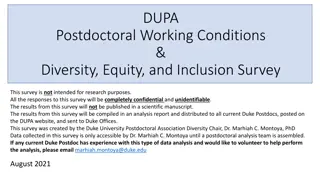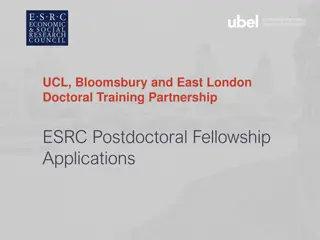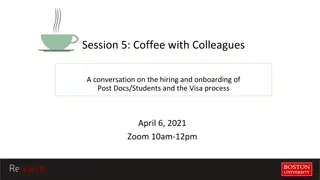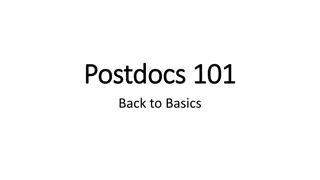CLIR/DLF Microgrants for Postdoctoral Fellows
Support collaborative projects for 2016-2018 CLIR/DLF Postdoctoral Fellows addressing cross-institutional issues. Eligible fellows must focus on Medieval Studies or data curation, forming teams to develop online resources or workshops benefiting broader needs beyond the fellowship community.
Uploaded on Sep 21, 2024 | 1 Views
Download Presentation

Please find below an Image/Link to download the presentation.
The content on the website is provided AS IS for your information and personal use only. It may not be sold, licensed, or shared on other websites without obtaining consent from the author.If you encounter any issues during the download, it is possible that the publisher has removed the file from their server.
You are allowed to download the files provided on this website for personal or commercial use, subject to the condition that they are used lawfully. All files are the property of their respective owners.
The content on the website is provided AS IS for your information and personal use only. It may not be sold, licensed, or shared on other websites without obtaining consent from the author.
E N D
Presentation Transcript
Postdoctoral Fellowship Program Microgrants Webinar February 22, 2017
What is the purpose of the CLIR/DLF microgrants? Support 2016-2018 fellows to conduct collaborative work addressing cross- institutional issues Project outcomes should help fellows AND address needs outside fellowship community Funding from Andrew W. Mellon Foundation & Sloan Foundation
Who is eligible to apply? Current 2016-2018 CLIR/DLF Postdoctoral Fellows (2 yr. appointments) Principal Investigator (PI) must be a Medieval Studies or Sloan supported data curation fellow, regardless of project focus Must form collaborative team of at least 2, including PI
What kinds of collaborative projects will be considered? Web or other technical development of tool or online resource relevant to fellowship work happening at multiple institutions Web or other technical development that would improve interoperability between related digital initiatives
What kinds of collaborative projects will be considered? Collaborative development and delivery of online session/workshop on topic related to digital tools and resources Collaborative development and delivery of skills-training workshop related to data curation
What are the requirements? Complete application consists of the following: Principal Investigator PI must be MS or Sloan data curation fellow, regardless of project focus Provide name and contact information Project Leaders Need at least 2 or more collaborators, including PI Provide names and contact information for all collaborators in proposed project
What are the requirements? Supervisor s Endorsement Upload a short message from each project participant's supervisor endorsing fellow s work on the project. Statement of Need Provide justification for the project as it relates to scholarship, librarianship, and/or data curation. Identify audience(s) that will benefit from the project, describe their relevant unmet needs, and summarize how the proposed project plan is designed to target these needs.
What are the requirements? Impact: List specific deliverables and other benefits of the project for the group(s) you have identified. For each deliverable, describe constituencies it will address and how it might be used by constituents to transform practice in research, teaching, librarianship, and/or data curation.
What are the requirements? Project Description: Provide brief description for the project, including Clear statement of project goals and objectives Activities required to implement the project Proposed timeline for these activities All projects must be completed no later than August 31, 2018 Lightweight assessment strategy that will help determine the project s success
What are the requirements? Project Resources: Personnel, Time, and Budget: List all people who will make significant contributions to the project, including their titles, institutional affiliations, and specific responsibilities related to the project. List all costs required to complete the project, providing justification for how each cost has been calculated and the sum total of all project costs. List all proposed travel expenses separately. Total project costs must be at least $1,500 but not exceed $10,000.
What are the requirements? Communication Plan: Describe variety of media and other means collaborators will use to document their progress and to reach audiences that will benefit from the project. Project and expenditure narrative for reporting purposes.
What is the selection process? Application deadline: June 1, 2017 Competitive process based on potential project s benefits to community Applicants notified of status: July 2017
Where is the application form? Link to application form in CLIR Connect Library https://app.wizehive.com/appform/login/clirp ostdocmicrogrants2017 Applicants must register and establish a new personal user ID and password within the application system. You cannot use the same ID and password from your postdoc application.
APRICOT A Peer-Reviewed Interdisciplinary Collection of Objects for Teaching Alexandra Bolintineanu Postdoctoral Fellow - University of Toronto Matthew Evan Davis Independent Scholar Tamsyn Rose-Steel (PI) Digital Scholarship Specialist - Johns Hopkins University Ece Turnator Digital Humanities Associate - University of Texas, Austin Bridget Whearty Assistant Professor in English and Medieval Studies - Binghamton University
What is APRICOT? A site where: Instructors can find teaching materials, upload materials, comment on and review materials. Get metrics on how their material is used. Create versions of materials with attribution carried forward and be able to trace the evolutionary path of those materials. * These metrics, review and demonstrated paths of evolution will be particularly useful for showing the value of our teaching materials and for starting to show committees for tenure or job search that our teaching can be reviewed, disseminated, and valued in our communities of practice just as our research.
The need for APRICOT Acknowledgment Community Respect Innovation Review
How does it work? At its most basic, APRICOT needs to be able to: Allow instructors to create or upload teaching objects. Create daughter copies of these teaching objects, which can be modified without changing the original, yet still maintain the connection between the two. Propagate these mother/daughter connections generationally, so that the daughter three generations down the chain still maintains the connection to the original item.
How does it work? This:
How does it work? Is really this:
How does it work? xslt transforms the Word document
How does it work? and wraps each character in a hidden bookmark with the required id.
How does it work? Bookmarks are hidden within the word doc.
Using Omeka Robust, growing community Usability Interoperability: standard formats export; OAI PMH Metadata: Dublin Core DH Pedagogy Traction in community of practice Digital Collections Management Omeka
Challenges Articulating the idea Rewriting the grant Avoiding scope creep Leading your peers Project management across several institutions Where next?
Thank you! Questions and comments? @MyApricotHub www.myapricot.org Alexandra Bolintineanu alexandrabolintineanu@gmail.com Matthew Evan Davis matthew@matthewedavis.net Tamsyn Rose-Steel (PI) @TamsynMedieval Ece Turnator turnakusu@gmail.com Bridget Whearty @BridgetWhearty T.Rose-Steel@jhu.edu bwhearty@binghamton.edu
Teaching Digital Approaches to Special Collections: TEI as a Mode of Primary Source Engagement in Undergraduate and MLIS Pedagogies Philip Palmer (PI UCLA Clark Library) and Charlotte Nunes (formerly of Southwestern U, now at Lafayette College) Lizzie Johnson Papers at Southwestern U Special Collections assignment had students work in pairs to transcribe and TEI- encode a single letter: http://bit.ly/2lSuAuR treating transcription and encoding as separate processes: requires repeated reading and re-reading of material slowing down, encoding as close reading student blog posts: http://bit.ly/2ljlESz AND http://bit.ly/2krs9mM One student remarked that the transcription and electronic editing process forced her team to slow down and really think about the text, which lead to additional questions about the document: who wrote the letter and why? who are the specific people and places mentioned in the letter?
UCLA Project training a UCLA MLIS student to transcribe and encode a C17th recipe manuscript paleographical training and text-encoding training, custom TEI schema work will contribute transcription to the Early Modern Recipes Online Collective (EMROC) project, the Folger s Early Modern Manuscripts Online (EMMO) project, and become part of the Clark s MSS digitization project (CLIR Hidden Collections) transcription online: http://bit.ly/2lStpeT
TOME (Toolkit of Material Evidence): Tracing Readers, Owners, and Users of Books Laura Aydelotte (PI UPenn Kislak Center) and Philip Palmer (UCLA Clark Library) TOME is an online toolkit for the study of provenance and book use that combines definitions of key terms with illustrative images, relevant online and print resources, and contextual essays Why do we need this resource? Thousands of digitized rare books online, but limited pedagogical apparatus around those digital objects. When a student views a physical or digitized rare book, how does she learn about unfamiliar features such as endleaf inscriptions, binding styles, and manuscript marginalia? Built in Scalar: supportive of multimedia, semantic data model, non-linear structure www.tometoolkit.org (additional content from Laura forthcoming)
Current Categories of Terms All terms explained by images, scope notes, related definitions, and references Exploring the Book pathway through the site: Roles: individual roles related to the ownership and use of books Places: specific sites of the book s physical architecture Questions: specific questions someone might ask of a book s marks of provenance and use
QUESTIONS?? Philip Palmer (UCLA): ppalmer@humnet.ucla.edu Charlotte Nunes (Lafayette College): nunesc@lafayette.edu Laura Aydelotte (UPenn): aydel@upenn.edu
Questions? See other examples of microgrant projects on the CLIR website at: https://www.clir.org/fellowships/postdoc/projsandpubs
